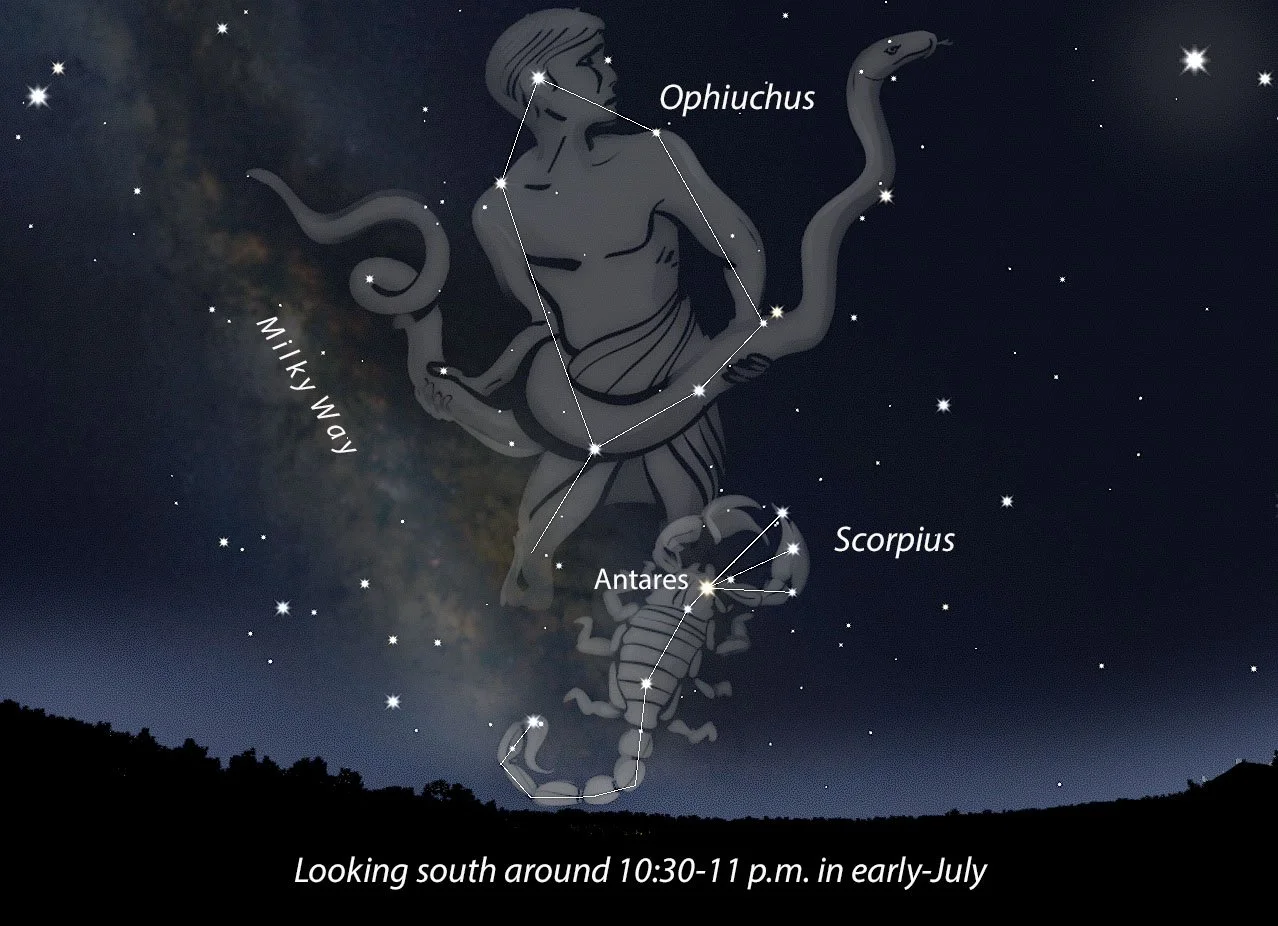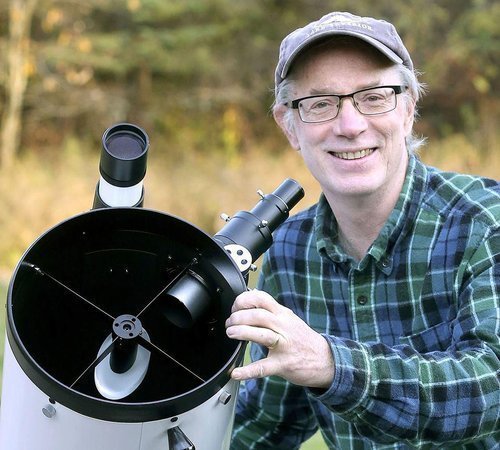July 2025 Night Sky Calendar
July 2025 Night Sky Explorer by Bob King
Mars drops into the twilight glare this month and disappears from view this month, leaving the evening sky temporarily without a bright planet. Meanwhile, Venus and Saturn – both beaming in the morning sky – welcome Jupiter into the fold. The gas giant makes its first appearance at mid-month in Gemini low in the northeast about an hour before sunrise. On July 22nd you can use the waning crescent moon to help you find it.
We’ve got some great stuff happening this month including two weeks of continuous, evening-to-morning space station passes (up to 5 per night) and a meteor shower during the wee hours of July 30th.
Our featured constellation is Ophiuchus the Serpent-holder (pronounced oaf-ee-YOO-cuss). As the god of medicine and healing, he’s shown wrestling a writhing snake – the constellation Serpens the serpent – with both hands. Serpens is the only constellation of the 88 that’s split in two, with the head on one side of Ophiuchus and the tail on the other. Ophiuchus is associated with Asclepius, the ancient Greek god of medicine. Not only did the healer’s cures save lives, he also could resurrect the dead, a skill in short supply these days.
Ophiuchus stands halfway up the southern sky at the end of evening twilight in July and looks like a gigantic church bell. Thousands of years ago, when astrologers conceived the zodiac – the 12 constellations the sun passes through during its yearly round of the sky – they deliberately left out Ophiuchus, even though it spends nearly three weeks within its borders. Twelve constellations (not 13) fit better with the 12 months of the year, which are based on the lunar cycle.
Download the free Stellarium Mobile app for Android and iPhone to help you find and identify the current planets and constellations. Do a Google search, then install the app, set it in night mode (red screen) and point your phone skyward. For a free July sky map and calendar go to www.skymaps.com/downloads.html I also update on auroras and other sky events on Facebook at https://www.facebook.com/astrobobking/
Events (a.m. indicates the event happens in the morning sky):
July 2 – First quarter moon. At this phase, the half-moon stands high in the southern sky at sunset.
July 3 – Waxing gibbous moon shines just 3 degrees to the lower left of Spica, Virgo’s brightest star
July 4-18 – Multiple space station passes approximately every 90 minutes from dusk till dawn! For a complete list of passes for your city, log in to Heavens-Above.com, select your location and then click the blue ISS link. Or download and install NASA’s Spot the Station app at the app store or Google Play.
July 6 – The dark edge of the waxing gibbous moon occults (covers) the star Fang, also known as Pi Scorpii, for observers across much of the U.S. and Canada. You’ll need a small telescope to see it. For details, including times when the star disappears, go to http://www.lunar-occultations.com/iota/bstar/0707zc2287.htm. Times there are in Universal Time (UT). To convert UT to Eastern Time, subtract 4 hours, 5 hours for Central, 6 hours for Mountain and 7 hours for Pacific.
July 10 – Full Buck Moon. Rises around local sunset and sets the next morning around sunrise. Named for the new antlers growing on male deer (bucks) this time of year.
July 16 (a.m.) – Waning gibbous moon shines directly above the planet Saturn in the morning sky
July 17 (a.m.) – Last quarter moon. The half-moon stands due south around the time of sunrise.
July 20 (a.m.) – Thick, waning crescent moon occults the Pleiades (Seven Sisters) star cluster in early morning twilight. Happens between about 3:40 a.m. and 5:30 a.m. Central Time for Upper Midwest observers. The moon sits right in the middle of the cluster around 4:30 a.m.
July 21 (a.m.) – Waning crescent moon shines above Venus in the northeastern sky at dawn.
July 22 (a.m.) – Skinny lunar crescent forms a flattened triangle 2 fists wide with Venus and Jupiter low in the northeastern sky at dawn
July 24 – New Moon. The moon lies in the same direction as the sun and is invisible in the daytime sky.
July 26 – Very thin lunar crescent shines to the left of Regulus in Leo low in the western sky around 40 minutes after sunset. Use binoculars!
July 28 – Waxing crescent shines to the lower left of Mars low in the western sky at dusk
July 29-30 (a.m.) – Maximum of the annual Southern Delta Aquariid meteor shower with up to 25 meteors visible in a dark sky. No moon will ruin the show. Best viewing between midnight and 4 a.m. local time. The later you’re up the more meteors you’ll see.
July 30 – Waxing crescent moon shines to the lower left of Spica in Virgo
Hoping your night skies are clear! - Bob
Bob King is an amateur astronomer, author, and passionate educator. He served as a photographer and photo editor at the Duluth News Tribune for 39 years and taught at the UMD planetarium. Bob’s work had a great impact on Voyageurs National Park. To achieve International Dark Sky Park certification, the park was required to host dark sky education events. Through the Night Sky Explorer webinars, the Conservancy was able to fulfill this component and help secure the certification for Voyageurs National Park. We can’t thank Bob King enough for sharing his talents and knowledge with the Conservancy community to support dark sky preservation.







